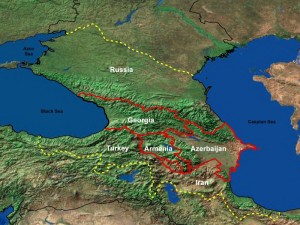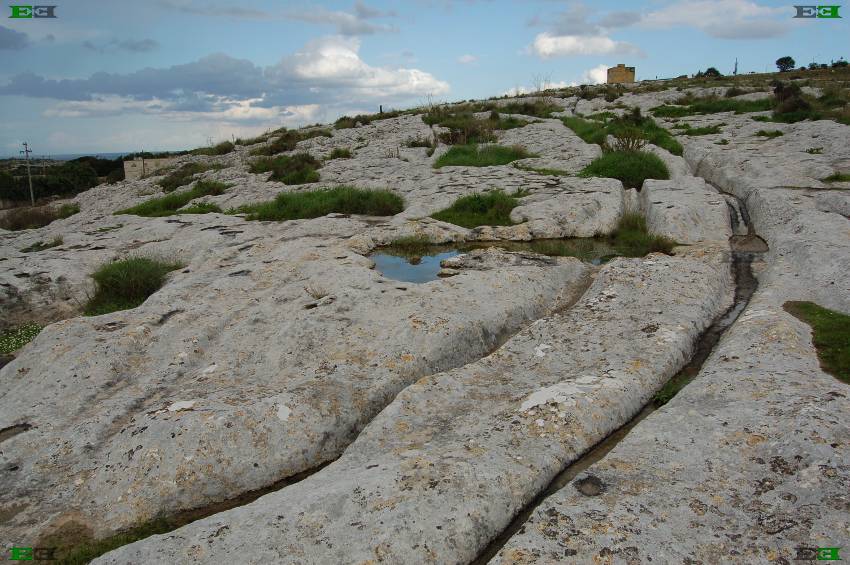Alexander Braghine
Caucasus Mountains
The Caucasus Mountains lie between the Black and Caspian Seas and contain the highest mountain in Europe, Mount Elbrus (Russia). In ancient times it was the location of several kingdoms of whom two were known as Albania and Iberia.(d)>Today, they contain a small part of the Russia Federation along with the former Soviet republics of Armenia, Azerbaijan and Georgia.<
mountain in Europe, Mount Elbrus (Russia). In ancient times it was the location of several kingdoms of whom two were known as Albania and Iberia.(d)>Today, they contain a small part of the Russia Federation along with the former Soviet republics of Armenia, Azerbaijan and Georgia.<
>Delisle de Sales was probably the first to suggest the Caucasus as the home of the original Atlantis, with refugees from there establishing Plato’s Atlantis in the Central Mediterranean. However, the greatest proponent of the Caucasus location for Atlantis was R.A. Fessenden who wrote, The Deluged Civilisation of the Caucasus Isthmus, an extensive multi-volume work [1012] on the subject published early in the 20th century.<
>Regarding the Pillars of Herakles being in the Caucasus Fessenden noted “The fact that Nebuchadnezzar, after reaching them in his northern expedition, next went to the north shore of the Black Sea and to Thrace; and that Hercules, coming back from the pillars with the cattle of Geryon, traversed the north shore of the Black Sea (see Megasthenes, quoted by Strabo and Herodotus, 4.8), puzzled the ancient geographers because they thought that the Pillars were at the straits of Gibraltar. And because they had overlooked the fact that the Phoenicians of Sidon had known that the Pillars had been lost and that the Phoenicians had sent out four expeditions to look for them but had reached no conclusion from these expeditions except that the straits of Gibraltar were not the true Pillars of Hercules.” See Strabo, 2.5 (m)<
More recently, Ronnie Gallagher, an admirer of Fessenden, has studied the Caucasus region, in particular,  the hydrology of the Caspian Sea(a), where he identified strandlines up to 225 metres above sea level (ASL), which he considers to be evidence of a vast inland Eurasian sea at the end of the last Ice Age. In Azerbaijan, he also found cart ruts similar to those on Malta as well as stone circles on the Absheron Peninsula(b). Professor E. N. Badyukova has offered some critical comments regarding Gallagher’s claims(k).
the hydrology of the Caspian Sea(a), where he identified strandlines up to 225 metres above sea level (ASL), which he considers to be evidence of a vast inland Eurasian sea at the end of the last Ice Age. In Azerbaijan, he also found cart ruts similar to those on Malta as well as stone circles on the Absheron Peninsula(b). Professor E. N. Badyukova has offered some critical comments regarding Gallagher’s claims(k).
Flinders Petrie also referenced Fessenden in his (1926) paper The Origins of the Book of the Dead(f), in which he concluded “that the cultural connections of the earliest Egyptians, as well as the physical descriptions in their mythology, point to the Caucasus region. When, further, we find there the names of the principal places of the mythology in their relative positions, it gives strong grounds for regarding that region as the homeland of the earliest civilisation of the Egyptians.”
A few years later, an article by Margaret A. Murray in Antiquity (Volume 15 – Issue 60 – Dec. 1941) noted that Petrie’s “opinion was based entirely on literary and philological evidence” resulting in archaeologists being slow to accept it. To partially counter this Murray offered two pieces of evidence in support of Petrie’s proposed Egyptian-Caucasus connection.(i)
However, I must point out that in 1874 Hyde Clarke delivered a paper to the Royal Anthropological Institute in which he claimed that the Colchians in the Caucasus had been an Egyptian colony(h). Clarke also employed language similarities>and Herodotus’ Histories (Bk2.102-106)< to support his contention. So we can reasonably ask, who was right or were both Clarke and Flinders Petrie wrong?
A forum on Graham Hancock’s website offered some more discussion about an Egyptian link with the Caucasus(j).
Jean-Michel Hermans has claimed that the megalith builders of Brittany originally came from the Caucasus, and arrived there after a stop in what is now Bulgaria around 5000 BC(l),>and while there, they discovered mathematical relationships such as ‘pi’ and the ‘golden ratio’ !<
The Amazons of Greek mythology are thought by some to have originated in the Caucasus and as late as 1671, Sir John Chardin reported that a tribe of Amazons existed in Georgia. Interestingly, a 19th-century photo shows two armed ladies from Armenia captioned as ‘Amazons of Armenia 1895’.
An added mystery was offered by Alexander Braghine, who recounted that “I was present when a former Russian officer of Georgian origin found himself able to talk with the natives of Vizcaya immediately upon his arrival in Northern Spain: he spoke Georgian, but the Basques understood this language.” [156.187]
Currently, Bruce Fenton has claimed the Caucasus as the home of giants. However, Jason Colavito has demonstrated the unreliability of his claims(c).
In the Krasnodar region of southern Russia hundreds (actually 3,000 and counting) of dolmens are to be found on both sides of the Caucasus. Interestingly, they show a distinctive form of megalithic architecture(g).
I feel that the Caucasus will have a lot more to tell us.
(a) Wayback Machine (archive.org)
(b) https://www.azer.com/aiweb/categories/magazine/ai103_folder/103_articles/103_cart_ruts.html
(d) https://en.wikipedia.org/wiki/Caucasian_Albania
(f) Archive 6947 | (atlantipedia.ie)
(g) The mysterious dolmens and megaliths of the Caucasus – The Tapestry of Time (larazzodeltempo.it)
(h) https://www.jstor.org/stable/pdf/2841305.pdf
(i) Antiquity, Vol. 15, Issue 60, Dec. 1941 p.384-386
(j) New article: Observations on Late Pleistocene Flooding of the… – Graham Hancock Official Website
(k) Archive 7221 | (atlantipedia.ie)
(l) Amazon.fr
Thayer Ojeda, Luis (L)
 Luis Thayer Ojeda (1874-1942) was a Chilean historian, linguist and keen euhemerist. He spent a long time studying Mediterranean mythologies and concluded that classical mythology is nothing more than a poetic form of a nation’s history. He believed that many of the peoples of Europe, conventionally assumed to have arrived from the east, had in fact come from the west – from Atlantis. Thayer Ojeda also supported the concept of an isthmus at Gibraltar and produced a hypothetical map of the Mediterranean before the breaching of the landbridge. Alexander Braghine wrote enthusiastically about Thayer Ojeda’s work[156.144/7], recommending two of his books, which unfortunately are only available in Spanish.
Luis Thayer Ojeda (1874-1942) was a Chilean historian, linguist and keen euhemerist. He spent a long time studying Mediterranean mythologies and concluded that classical mythology is nothing more than a poetic form of a nation’s history. He believed that many of the peoples of Europe, conventionally assumed to have arrived from the east, had in fact come from the west – from Atlantis. Thayer Ojeda also supported the concept of an isthmus at Gibraltar and produced a hypothetical map of the Mediterranean before the breaching of the landbridge. Alexander Braghine wrote enthusiastically about Thayer Ojeda’s work[156.144/7], recommending two of his books, which unfortunately are only available in Spanish.
Onffroy de Thoron, Enrique
Enrique Onffroy de Thoron was a French aristocrat whose family fled their homeland following the French Revolution(a). He was not Brazilian as claimed by Alexander Braghine. He travelled the world eventually settling in South America where he studied the language of the indigenous people of Peru. He later returned to France where he published the results of his research.
He believed that Atlantis was Phoenician and situated in America[0901]. According to Braghine, Onffroy de Thoron claimed that the Atlanteans along with the Andean Quichua tribe invaded Europe! Among his other strange conclusions (or should that be delusions?) was that the Carians of western Anatolia (Turkey) had populated the south-western shores of South America and that a Carian dynasty had once ruled in Quito (Ecuador)[156]!
*(a) https://web.archive.org/web/20160317092445/https://onffroy.com/2_7_Jamaica.html*
Meillet, Paul Jules Antoine (L)
 Paul Jules Antoine Meillet (1866-1936) was a leading French linguist in the early part of the 20th century. He is probably best known for his Persian, Armenian and Homeric studies. Alexander Braghine claimed[156.43] that Miellet believed that all European languages were derived from the original tongue of the Atlanteans.
Paul Jules Antoine Meillet (1866-1936) was a leading French linguist in the early part of the 20th century. He is probably best known for his Persian, Armenian and Homeric studies. Alexander Braghine claimed[156.43] that Miellet believed that all European languages were derived from the original tongue of the Atlanteans.
Barroso, Gustavo
 Gustavo Barroso (1888-1957) was a Brazilian writer and right-wing ‘Integralist’ political leader as well as an unambiguous anti-semite. His 1931 book, Aquém da Atlântida[1346], included Nazi ideology as well as the concept of ‘vril’ energy and a denunciation of communism. To say the least the book had little to do with Plato’s Atlantis(a). However, Alexander Braghine recommended this book as worth reading in connection with ancient links between the ‘Old World’ and the Americas[156.171].
Gustavo Barroso (1888-1957) was a Brazilian writer and right-wing ‘Integralist’ political leader as well as an unambiguous anti-semite. His 1931 book, Aquém da Atlântida[1346], included Nazi ideology as well as the concept of ‘vril’ energy and a denunciation of communism. To say the least the book had little to do with Plato’s Atlantis(a). However, Alexander Braghine recommended this book as worth reading in connection with ancient links between the ‘Old World’ and the Americas[156.171].
(a) Wayback Machine (archive.org) * or see Archive 3091)
Pereira de Lima, Jose Maria (L)
José Maria Pereira de Lima (1853-1925) was a Portuguese lawyer and historian. Among his many books was Iberos e bascos[897] in which we are informed by Alexander Braghine[156.120] that “de Lima was of the opinion that the sinking of Atlantis was due to a sudden inclination of the plane of the ecliptic, followed by an instantaneous translation of the magma.”
The original text is online(a).
Cart-Ruts *
The Cart Ruts of Malta are one of the many remarkable archaeological features of the archipelago. Unfortunately, the local authorities have not done all they could to ensure their preservation. Cart ruts are also found in other countries but with nothing like the numbers found in Malta.
Sardinia has a number of comparable cart ruts that have only recently received the attention they deserve. Dr Dominique Görlitz has studied these cart ruts(ai). Images of the Sardinian ruts can also be seen in a YouTube video(aj).
An article written in 1904(h) describes a visit to the Madeiras where the writer travelled on a sled drawn by oxen, while Alexander Braghine describes how Paul le Cour visited the Azores and noted that the natives there used ‘sledges’ rather than wheeled vehicles and greased the runners to assist movement, similar to the practice on the Madeiras. A more recent paper(s) by Félix Rodrigues of Azores University discusses in detail cart ruts found on Terceira Island in the Azores. Other papers(w)(x) on the Academia.edu website discuss ‘ruts’ on Lanzarote in the Canaries.
Uwe Sneider has produced the most comprehensive overview of the geographical distribution of cart ruts that I have encountered(ak). He has visited many of the sites in the Mediterranean and across Europe and has alluded to possible traces of ruts on other continents.
An image (4th down) from Malta on a 2017 posting(af), appears to show where axles have worn into a raised stone wall at one side of a rut, which would seem to end the ‘sledge versus wheel’ controversy.
Another feature of the ruts found in Malta is the inexplicable manner in which some will suddenly disappear at cliff edges! Furthermore, ruts are also found disappearing into the sea on one side of a bay and then reappearing on the opposite side. Over a century ago Emanuel Magri reported that there were cart ruts on the tiny island of Filfla, which lies 5km off the south coast of mainland Malta, suggesting the disappearance of a very large tract of land between the two.
The melitamegalithic website has linked the altered orientation of Malta’s temples with the geological disruption indicated by the cart ruts (ae) noting that “While the geology of the Maltese islands indicates unmistakably major events of a cataclysmic nature, these give little hint as to what took place, and when. What is definitely obvious is that the geologic events are evident from man-made artefacts. Those artefacts point to the kind of event and the time when it occurred. In geological time they are quite recent.”
“The earliest reference to cart-ruts was made by Gian Francesco Abela (1582–1655) in 1647 [1676] who suggested that they were used to transport stones from quarries to the sea for exportation to Africa during the Arab rule in Malta.”(z)
Dr David Trump (1931-2016) who has done much to advance Maltese archaeology, published a booklet on the cart-ruts in 2008 [658]. Trump nicknamed the complex collection of ruts at Misrah Ghar il-Kbir “Clapham Junction” after the London railway station, where several railway services interchange. A 1998 paper(d) by Joseph Magro Conti and Paul C. Saliba focused on “Clapham Junction” and concluded that the ruts had a clear connection with the transportation of material from adjacent quarries.
Speaking of railways, Ralph Ellis has written on the suggestion that the standard British railway gauge may have had its origins in the cart ruts of Malta or ancient Egyptian cubits!(ag)
A connection between the cart ruts and Atlantis has been suggested by Anton Mifsud and adopted by the late Axel Hausmann, who both claim that the ruts were the irrigation channels referred to by Plato (Critias 118c-e).
Another prominent archaeologist, Claudia Sagona, has also suggested(f)(j) that the ruts were used for irrigation, although she has not associated them with Plato’s text. While this linkage fits nicely with the theory of Atlantis having been in the region of Malta, it does not stand up to close examination.
First of all the cart ruts follow the natural undulations of the Maltese landscape and so to function as irrigation channels would require water to flow uphill for parts of its journey, Trump has mentioned how some of the ruts can be seen sloping as much as 45°. Roman aqueducts, like the one in Malta’s Rabat(ac)(ad), seldom used a gradient greater than half of one percent.
Secondly, the fact that the ruts are always found in pairs would suggest a degree of unnecessary and wasteful duplication found in no other irrigation system in the world. Because; if the ruts were intended to carry water, for the same labour they could have been cut as a single channel at twice the depth cutting losses through evaporation by half.
As well as that, the ground between each pair of tracks could provide an extra acre of arable land for every two miles of length. Furthermore, the multiplicity of tracks at the ‘Clapham Junction’ site is incompatible with an irrigation system.
All of which is compounded by the absence of controlling sluicegates anywhere at the remaining 100+ sites, and emphasised by Trump’s observation that “no association of ruts with water sources has been demonstrated.”[870.268]
I refer below to several countries where comparable cart ruts have also been found. I am not aware of even one instance where any of these have been suggested as having an irrigation function.
Compounding all that is the fact that no supporter of the cart ruts as Plato’s irrigation channels has attempted to explain how the dimensions of the ruts can be measured in inches while Plato describes canals measured in feet – tens of feet!
Joseph S. Ellul in his book Malta’s Prediluvian Culture [0289] expressed some controversial unconventional views(t) regarding the cart-ruts, including his assertion that the ruts were created by tools or machinery and were formed during the Stone Age before the biblical Deluge! A chapter from his book focussed on the cart ruts has been translated(ah) into German and published by Atlantisforschung. With the help of Google Translate, I have added an English text below (See: Archive 7256P).
Graham Hancock refers to the cart ruts several times in Underworld [274], where he commented that “It is certain, too, that they were not simply worn away in the tough limestone by the passage of cart-wheels over periods of centuries, as many have wrongly theorized; on the contrary, there is no proof whatsoever that cart-wheels ever ran in these ruts – which were initially carved out of the bedrock with the use of tools.” [p.331] His claim that the ruts were hand-carved is disputed and Gordon E. Weston in his excellent book [754.172] debunks the idea.
Philip Coppens wrote a paper on the ruts, offering an overview of the controversies relating to their use and date(aa).
By way of comic relief, I thought I should include one theory regarding an explanation(c) for the ruts from Laura Knight-Jadczyk, a noted conspiracy theorist, which I quote in full: “Do I have an idea to propose? Of course I do. I wouldn’t be writing about it if I didn’t. I would like to suggest that these “ruts” look an awful lot like places where lightning has struck, and the electricity has blasted away the dirt and rock as it shoots along some sort of natural earth power grid conductor. The only difference is that the cart ruts are not random. That suggests that there was something present in the ground laid out in a definite grid, which acted as a conductor. Were the cart ruts some sort of networked energy conduction system? Could some sort of element have been placed in the ground by an ancient civilization; something that conducted power to their homes the way our vulgar power poles and lines crisscross the landscape? And then, at some point in time, was the earth hit by such a surge of energy from some unknown source that these power “lines” melted the rock in which they were “strung?” Perhaps a surge of some kind of cosmic energy source? Maybe even the Electromagnetic pulse of a nuclear explosion? Maybe it was neither of these, but merely a massive overheating of the surface of the earth so that the conduction element and its insulating covering melted and was swept away?”
One of the more bizarre suggestions has been proposed by Markus Tutsch on the German EFODON website, that the parallel ruts were used in some way to distribute electrical power(q)!!!
Another comical suggestion is offered by Dr Cornelius Niels Kopf who has proposed that “The Bronze Age traces on Malta and Gozo and many other parts of the then populated world, known as cart ruts, were sports facilities, and the area designated as ‘Clapham Junction’ was apparently the ‘stadium’ of Malta.” (r)
 In 2010, the most comprehensive work on the ruts, that I’m aware of, was published by Gordon E. Weston[754]. Weston now has a website(g) where he discusses the ‘ruts’ further and provides additional links. Weston also published Clapham Junction: 3000 Years of Maltese Heritage, in 2015 [1619].
In 2010, the most comprehensive work on the ruts, that I’m aware of, was published by Gordon E. Weston[754]. Weston now has a website(g) where he discusses the ‘ruts’ further and provides additional links. Weston also published Clapham Junction: 3000 Years of Maltese Heritage, in 2015 [1619].
There are also several websites devoted to the investigation of these enigmatic features(a). One of them(m) offers a fine collection of images, including the one above, as well as a discussion on the origin, use, and questions raised by the Maltese cart ruts.
A study of the ruts by three geomorphologists at Portsmouth University, published in Antiquity, is a valuable addition to the literature on the subject(b). The authors “that the ruts could be caused by two-wheeled carts with a gauge of 1.40m carrying moderate loads. In wet weather the carts would gradually cut into the limestone and reach their ground clearance of 0.675m, causing the carriers to try another route – so there are plenty of them.”
Uwe Topper has written an extensive paper on cart ruts around the Mediterranean and beyond(i). He controversially theorised that the ruts were created when the limestone on which they were cut was ‘softer’!!!
A short April 2015 video clip(l) demonstrates how even a 20kg quarter-scale slide-car, can with one pass cut a 1mm groove into the soft Maltese limestone, near Sliema. A full-scale slide-car would be carrying 320 Kg.
Amateur archaeologists, Ronnie Gallagher and Abbas Islamov have highlighted the existence of cart-ruts in the Gobustan peninsula of Azerbaijan (e).
In a 2014 article(k)(ak) on the Mysteria 3000 website, André Kramer drew attention to the cart-ruts discovered on Mallorca, the principal island of the Balearic archipelago.
Evidence exists for cart ruts in other countries in Europe, such as Switzerland, and much further afield including South America(u). The same site makes two interesting points, (1) since the earliest carts probably lacked brakes, the repeated use of the ruts gave some small degree of control, and (2) without any obvious passing points the ruts seem to indicate that they were limited to one-way traffic.
In 2015, Russian geologist Alexander Koltypin drew much media attention(o) when he claimed that comparable tracks in the Phrygian Valley of Turkey were dated to 14 million years ago and were created by an unknown civilisation. He also implied that the cart ruts of Malta had a similar origin! However, a quick look at his website(p) revealed him to have travelled well beyond the lunatic fringe.
I find it interesting that much more investigation of the Maltese cart ruts has been carried out by foreigners than by natives of the islands. A recent example is the inventory of ruts recently published by Monika I. Trinkler, a Swiss photographer, who has listed 717 pairs on Malta and 43 on Gozo Dec. 2020). Her interest in the Maltese ruts has now expanded into the identification of ruts throughout Central Europe(v).
Unfortunately, the date and function of the ruts are still sources of intense debate, particularly in Malta itself. In 2017, Anthony Bonanno published The Archaeology of Malta and Gozo [1665] in which he argued for a Roman rather than a prehistoric date for the cart ruts. This runs counter to the opinion of many, particularly that of the late David Trump. In 2019, Anton Mifsud published a rebuttal of Bonanno’s claims in a fully illustrated book entitled David’s Ruts [1666], published as a tribute to the work carried out by David Trump on Malta.
In August 2021, it was announced that some of Malta’s cart ruts were to be covered by a new airport roundabout(ab)! A comment is unnecessary.
(a) https://web.archive.org/web/20190102032648/https://cartruts.com/
(c) https://www.cassiopaea.com/cassiopaea/adventures247.htm
(d) https://www.angelfire.com/ar/magrosalibarchaeo/
(e) https://www.azer.com/aiweb/categories/magazine/ai103_folder/103_articles/103_cart_ruts.html
(f) Oxford Journal of Archaeology (Vol.23, Issue 1, p.45-60)
(g) https://cartrutanswers.com/index.html (offline 15/07/14)
(h) See: https://web.archive.org/web/20110616093830/https://www.oldandsold.com/articles09/travel-45.shtml
(i) http://www.ilya.it/chrono/pages/gleisedt.htm (german)
(j) https://www.stonepages.com/news/archives/000350.html
(k) Cart-Ruts auf Mallorca – Mysteria3000 (archive.org)
(l) https://www.youtube.com/watch?v=M4y2aLns5So
(m) Cart Ruts Malta – Maltas Cart Tracks – others aound the world (archive.org)
(n) Archive 3036
(p) Earth before the Flood: Disappeared Continents and Civilizations (archive.org) *
(q) https://www.efodon.de/html/publik/sy/SY132/SY13239 Tutsch – Cart Ruts.pdf
(r) Archive 6308 & Archive 6309
(s) https://www.academia.edu/37215162/Dating_the_Cart-Ruts_of_Terceira_Island_Azores_Portugal
(t) https://web.archive.org/web/20050301092052/https://www.truegood.fsnet.co.uk/hagarq5.htm
(u) http://www.ancient-wisdom.com/cartruts.htm
(v) https://malta-cartruts.ch/
(z) http://www.ancient-wisdom.com/cartruts.htm
(aa) https://web.archive.org/web/20200420044822/https://www.eyeofthepsychic.com/cartruts/
(ac) ~~ Roman Aqueduct System at Rabat – Eugene P Teuma – Culture Malta Culture Malta (archive.org)
(ad) https://www.academia.edu/1819676/QANAT_SAQQAJJA_and_ROMAN_AQUEDUCT_SYSTEM_at_RABAT_MALTA
(ae) https://melitamegalithic.wordpress.com/2019/09/25/beyond-the-he*retic-reality/
(ag) https://cdn.preterhuman.net/texts/religion.occult.new_age/occult.conspiracy.and.related/Ellis,%20Ralph%20-%20Assorted%20Articles.pdf (see ‘Ancient Egyptian Railways’)
(ah) Cart Ruts – Mysteriöse Wagenspuren auf Malta – Atlantisforschung.de (German)
(ai) On the trail of the Cart Rut mystery – Atlantisforschung.de (atlantisforschung-de.translate.goog)
(ak) Cart-ruts – Eine Annäherung an ein archäologisches Mysterium (www-cartruts-de.translate.goog) (English)
https://www.cartruts.de (German)
Hamy, Ernest Theodore (L)
Dr. Ernest Theodore Hamy (1842-1908) was a French doctor of medicine,  although he was better known as an anthropologist. Alexander Braghine[156.42] quotes Hamy as locating Atlantis in the Atlantic between Spain, Ireland and North America.
although he was better known as an anthropologist. Alexander Braghine[156.42] quotes Hamy as locating Atlantis in the Atlantic between Spain, Ireland and North America.
Hamy also gave his name to the famous King-Hamy Map (c.1502), which he purchased in 1885. One of the remarkable features of the map is that it shows the Sahara as a fertile region with rivers, lakes and cities!
Bilau, Kurt
Kurt Bilau (1872-1941) had been a Major in the Kaiser’s Imperial Artillery Corps. He also achieved  some fame as the inventor of a more efficient windmill for generating electricity. He, along with millions of others, was apparently seduced by the Nazi regime, but still managed to retain some independence of thought regarding Atlantis.
some fame as the inventor of a more efficient windmill for generating electricity. He, along with millions of others, was apparently seduced by the Nazi regime, but still managed to retain some independence of thought regarding Atlantis.
>The late Bernhard Beier wrote a number of articles for Atlantisforschung relating to Bilau’s Atlantis ideas, his attraction to Hörbiger’s theories as well as his political leanings towards National Socialism(c).<
His Atlantis theory incorporated much of Hans Hörbiger’s cosmological ideas. Between 1932 and 1940 he wrote a number of Atlantis-related articles for Schluessel zum Weltgeschen, a journal dedicated to Höbiger’s ‘World Ice’ theory.
>In his 1935 book (Die Offenbarungen des Johannis – Ein Mondniederbruch vor 11 400 Jahren” entnommen)(The Revelations of St. John – A Moon Collapse 11,400 years Ago p. 57-61) Bilau endeavoured to support Hörbiger’s theories with his interpretation of biblical texts specifically from the Revelations of St John and the Book of Daniel(a)(b). A few years later Hans Bellamy described Revelations as “a collection of cosmological myths” in The Book of Revelation is History [097]. In it, he also sought to interpret The Book of Revelation as offering a description of the capture of our Moon and the ensuing catastrophes caused by the event.<
Bilau considered Atlantis to be a large island sitting on the Mid-Atlantic Ridge, inhabited by late Cro-Magnons 11,400 years ago. Bilau considered, the Azores to be the remnants of Plato’s large island. More specifically, he thought that the Atlantean capital had been situated on the Dollabarata Reef south of the Azores.
Bilau also calculated the date of the destruction of Tiahuanaco as circa 9500 BC concurring with the conclusions of Poznansky. Braghine noted that Bilau also calculated that the Andes had at one time been 3,500 metres lower based on the discovery of a 550km stretch in the district of Titicaca of the remains of a particular seaweed which left a white deposit at that height[156.265].
(b) The Revelations of John – Atlantisforschung.de (atlantisforschung-de.translate.goog) *
Myths
Myths along with legends and nursery thymes are part of a culture’s folklore. The word is given a primary meaning in dictionaries of “a traditional story of unknown authorship, serving usually to explain some phenomenon of nature, the origin of man, or the customs, religious rites etc. of a people. Mythological ‘gods’ were frequently personifications of those natural phenomena. A secondary meaning is ‘fictitious story’ which is the usual dismissive and derogatory application of the term to the Atlantis story. Time and time again, various ‘myths’ across a wide range of cultures have been shown to have a factual basis. These myths were generated to explain something that is important but incomprehensible. Sometimes myths are imported from other cultures and languages, leading to possible distortion of the original tale.
J. V. Luce, the Irish classics scholar, has highlighted[0120.14] how various Greek myths and legends have been proven to contain historical elements and that Plato’s Atlantis story should be studied with this in mind.
Alexander Braghine quotes the French historian, Gustave Glotz (1862-1935), who wrote in his History of Greece, that “it is a well-known fact that legend comes before history, but an attentive and rigorous analysis of any myth gives us the opportunity to detect historical data even in a myth. The comparative method is very useful in these cases.”
Luce has also pointed out that Plato also uses ‘logos’ or truth rather than ‘muthos’ or legend when referring to the Atlantis story.
Euhemerus (circa 300 BC) was one of the first to propose that the ‘gods’ of Greek myth were in fact ancient heroes that were, by convention, posthumously ‘deified’ by their bardic biographers.
It is perfectly reasonable to assume that the older a myth is the less specific detail it may retain regarding any underlying truth. I would suggest that Plato’s story has at least two elements; (i) an ancient and powerful civilisation was destroyed through inundation hundreds if not thousands of years earlier and (ii) the detailed description of an expansionist Bronze Age alliance that was also destroyed. The first, because of its antiquity, is of necessity vague; the second is incredibly detailed in the manner of an eyewitness account.
The ancient Greeks were apparently not conscious of the last Ice Age and the consequent effects of the melting of the retreating glaciers. Today we are aware of these events and find it interesting that Plato’s description of the flooding of Atlantis and its date appears compatible with real prehistoric facts, although the melting of the glaciers was a relatively slow process and is highly unlikely to have submerged Atlantis in ‘a day and a night’. The second element in Plato’s story is too detailed to be considered as fact but could be accepted as a reasonable embellishment by Plato who in order to emphasise the might of the earlier civilisation, ascribed to it all the trappings of contemporary imperial nations such as the Persians.
Robert Bowie Johnson, Jnr has promoted(c) the idea that the Adam and Eve in Genesis are the counterparts of Zeus and Hera in Greek mythology.
Before writing was developed our ancestors artfully used the rhyme and rhythm (meter) of poetry as a vehicle to ensure the faithful conveyance of their legends and traditions over countless generations. However, the details are often misunderstood or corrupted when such traditions are translated into different languages and the aide memoire value of the original poetry is lost. Even when writing was available but known only to an elite few, the function of verse as a transmission vehicle continued for thousands of years.
The value of traditional stories was highlighted by a recent paper presented at a conference in Japan which resulted from a study of Aboriginal stories from around the Australian coast(d). The details in those stories, relating to the rising sea levels at the end of the last Ice Age, coincide with remarkable accuracy to what has already been demonstrated scientifically. The conclusion is that these oral traditions can reliably span at least ten millennia and raise questions regarding the value traditional tales in other parts of the globe.
The Internet provides useful access to various mythological resources. One of those is Mythopedia(a) which has a valuable collection of articles and images dealing with mythologies and religions and the possible influence of ancient celestial sights on some aspects of them.
A paper(b) available on the internet by R. Cedric Leonard discusses with his usual thoroughness, various traditions and mythologies that may have contained details of the Atlantis story before Plato wrote his Timaeus and Critias dialogues.
In 2009, a paper(e) on the reliability of orally transmitted myths by Rens Van der Sluijs was published on the thunderbolts website. The same is said of the accuracy of nursery rhymes and other folk tales(f) some of which were of a more secular and sometimes subversive nature(g).
A groundbreaking overview of mythology is on offer[1431] from E. J. Michael Witzel (1943- ) who has traced the origins of many our myths to origins in Africa 100.000 years ago with the understandable revisions and accretions as humans spread throughout our planet, producing both new and local variations of the same themes. His influence today is seen by some, but not all, as comparable to that of James Frazer (1854-1941) and Eliade Mircea (1907-1986).
In 2020, Richard McQuillen published the first draft of A Simple Chronology of Greek Mythology, in which he was inspired by Herodotus to develop his own methodology and applied it to the histories of Athens, Crete and Egypt(h). He concluded “I have attempted to create a mythological timeframe for a majority of the Greek Mythological Kings in Greece. These timeframes have been tied to real world events like Troy. They have been synchronized with known timeframes of Egyptian Pharaohs. I list the kings of 20 different ancient cities and attempted to synchronize their history. I have created a framework to compare likes with likes and show when and where one might expect to find these names in Archaeology.”
(b) See: https://web.archive.org/web/20170113172919/https://www.atlantisquest.com/Myth.html
(c) https://www.ancient-origins.net/myths-legends-europe/zeus-and-hera-0012944
(d) https://theconversation.com/ancient-aboriginal-stories-preserve-history-of-a-rise-in-sea-level-36010
(e) https://thunderbolts.info/tpod/2009/arch09/090127whispers.htm
(h) (99+) A Simple Chronology of Greek Mythology -First Draft | Rich McQuillen – Academia.edu *

